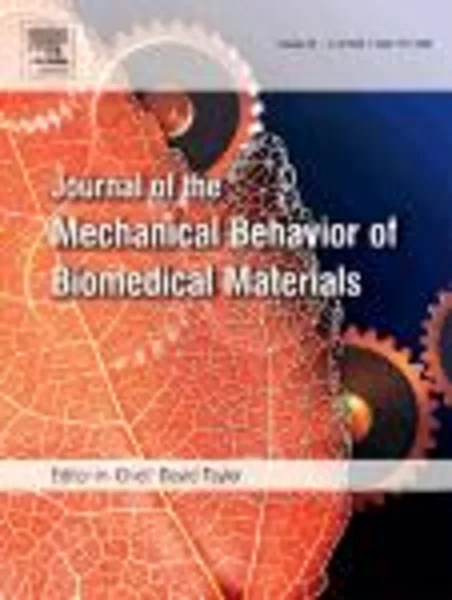-
mechanical characterization and numerical simulation of polyether–ether–ketone (peek) cranial implants
جزئیات بیشتر مقاله- تاریخ ارائه: 1394/01/01
- تاریخ انتشار در تی پی بین: 1394/01/01
- تعداد بازدید: 744
- تعداد پرسش و پاسخ ها: 0
- شماره تماس دبیرخانه رویداد: -
cranial implants have experienced a significant evolution in the last decade in different aspects such as materials, method of fixation, and the structure. in addition, patient-specific cranial implants have recently been started to be developed. to achieve this objective, efficient mechanical characterization and numerical modeling of the implant are required to guarantee its functionality on each patient as well as to facilitate further developments. in this work, mechanical characterization and numerical models have been performed for patient-specific polyaryletherketone (peek) scaffold cranial implants. mechanical characterization has been performed at the scaffold and the whole implant levels under displacement control tests. two different implant designs for the same patient but with different scaffold structure were experimentally characterized, and finite element models of the implants were developed within the framework of linear elasticity. two types of finite element models were developed: a detailed finite element model with the actual scaffold geometry, and a solid shell-like model with effective material properties. these effective material properties were obtained by means of the asymptotic expansion homogenization (aeh) theory which accounts for the periodicity of the underlying structure of the material. experimental results showed a linear response of the material and the implant up to failure, therefore supporting the use of linear elastic models for simulation. numerical models showed excellent agreement with experiments regarding load–displacement response. models also showed a very consistent behavior with regard to the location and the value of the maximum principal stress in the implant when subjected to the maximum load of the experiments. the two numerical models were compared. the homogenized model gave results that were very close to those obtained with the detailed model, while reducing the number of degrees of freedom by 90%, and therefore the overall computational burden. the results showed that the models are able to reproduce experimental results conducted on actual implants, offering a valid alternative to be used in the design of customized cranial implants with a scaffold structure.
مقالات جدیدترین رویدادها
-
استفاده از تحلیل اهمیت-عملکرد در ارائه الگوی مدیریت خلاقیت سازمانی و ارائه راهکار جهت بهبود
-
بررسی تاثیر ارزش وجوه نقد مازاد بر ساختار سرمایه شرکت های پذیرفته شده در بورس اوراق بهادار تهران
-
بررسی تأثیر سطح افشای ریسک بر قرارداد بدهی شرکت های پذیرفته شده در بورس اوراق بهادار تهران
-
بررسی تأثیر رتبه بندی اعتباری مبتنی بر مدل امتیاز بازار نوظهور بر نقد شوندگی سهام با تأکید بر خصوصی سازی شرکت ها
-
تأثیر آمیخته بازاریابی پوشاک ایرانی بر تصویر ذهنی مشتری پوشاک ایرانی (هاکوپیان)
-
بررسی فرآیندهای ژئوشیمیایی حاکم بر کیفیت آب زیرزمینی آبخوان عقیلی، استان خوزستان
-
مطالعه و بررسی آزمایش های مربوط به بتن خود متراکم (scc) در فاز خمیری و تفسیر نتایج بدست آمده
-
مقایسه عددی رفتار ستون های cfst و srcfst تحت بارهای متناوب
-
بررسی تاثیر تقلب در اعتبار اسنادی صادره از بانک ها در حقوق ایران
-
تحلیل پایداری چاه توسط معیارهای شکست مور – کلمب و موگی – کلمب در یکی از مخازن جنوب غرب ایران
مقالات جدیدترین ژورنال ها
-
مدیریت و بررسی افسردگی دانش آموزان دختر مقطع متوسطه دوم در دروان کرونا در شهرستان دزفول
-
مدیریت و بررسی خرد سیاسی در اندیشه ی فردوسی در ادب ایران
-
واکاوی و مدیریت توصیفی قلمدان(جاکلیدی)ضریح در موزه آستان قدس رضوی
-
بررسی تاثیر خلاقیت، دانش و انگیزه کارکنان بر پیشنهادات نوآورانه کارکنان ( مورد مطالعه: هتل های 3 و 4 ستاره استان کرمان)
-
بررسی تاثیر کیفیت سیستم های اطلاعاتی بر تصمیم گیری موفق در شرکتهای تولیدی استان اصفهان (مورد مطالعه: مدیران شرکتهای تولیدی استان اصفهان)
-
بررسی اثر بخشی فناوری اطلاعات بر عملکرد مدیران مدارس شهرستان لردگان
-
مطالعه ای بر تاثیر رسانه های اجتماعی در تشویق و ترغیب مردم برای مشارکت در انتخابات ریاست جمهوری 1400
-
تراداستان و سفر تراداستانی: گونه ها و کاربست ها
-
spatial analysis of quality of life in economic dimension of villages of lahijan town
-
a comparative study of the carbonyl positioning mechanism in the mn (co) 5 ch2f and mn (co) 5chf2 complex through quantum chemistry




سوال خود را در مورد این مقاله مطرح نمایید :